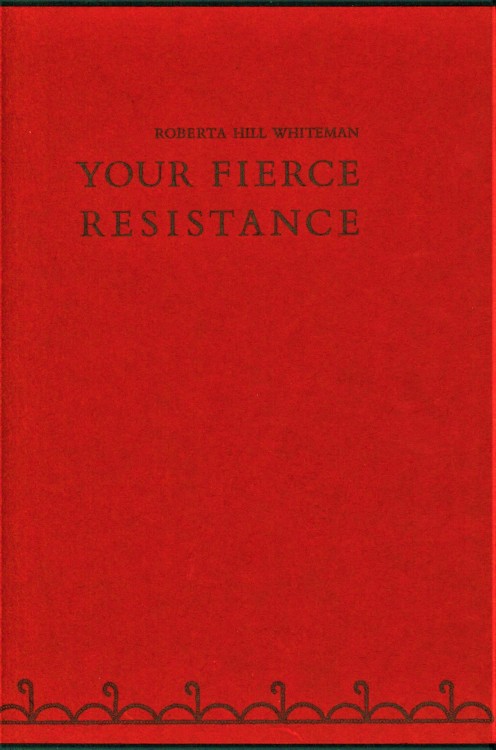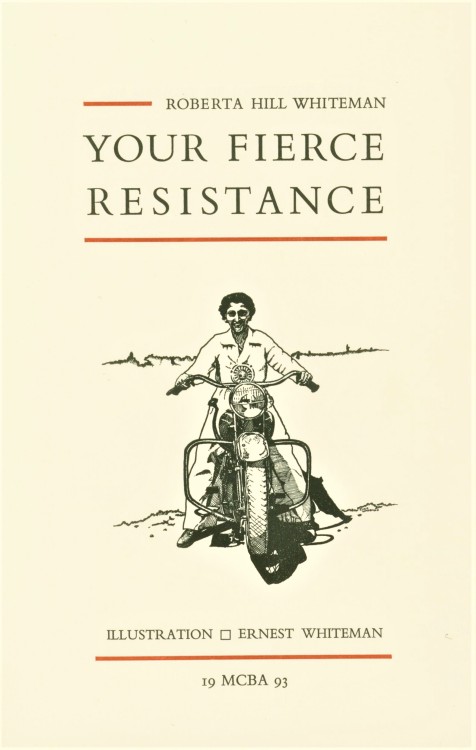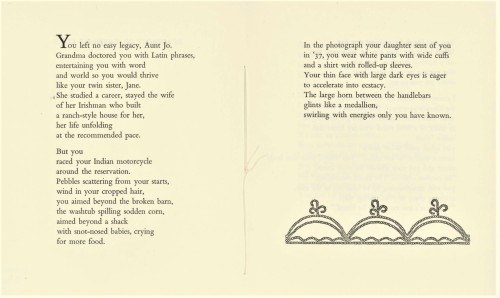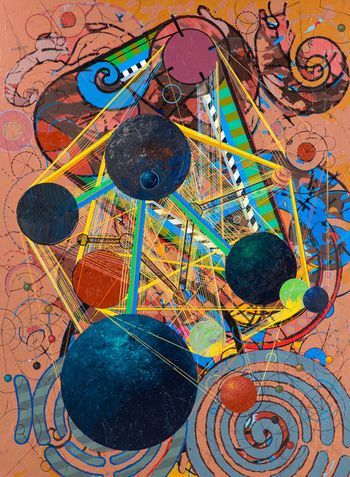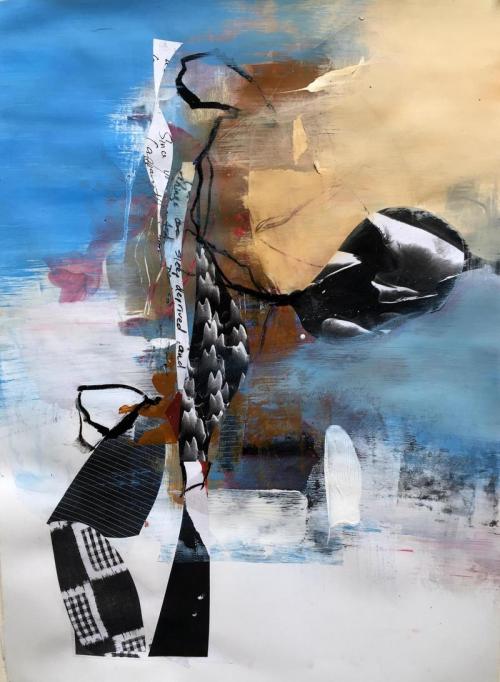#national endowment for the arts
First Nations Fine Press Friday
Roberta Hill
In association with our post this weekonRoberta Hill, we present the fine press printing of an excerpt from Hill’s 1993 poem, Your Fierce Resistance. Printed in an edition of 150 copies at the Minnesota Center For Book Arts (MCBA) in conjunction with literary center The Loft for theInroads: Writers of Colorseries,Your Fierce Resistance is an excerpt of a longer poem of the same title. The full-length poem can be found in Roberta J. Hill’s (then, Roberta Hill Whiteman) second poetry book collection, Philadelphia Flowers: Poems, published by the Holy Cow! Press in 1996. The edition was was printed by Robert Johnson of the Melia Press and wood engraver, printer, designer, poet, and illustrator Gaylord Schanilecusing Bembo type on Mohawk Superfine paper, with Fabriano Italia endsheets and Moriki Over Arches covers, supported in part by a grant from the National Endowment for the Arts.
Hill completed her PhD with a biographical study of her paternal grandmother, Dr. Lillie Rosa Minoka-Hill—the second American Indian woman to earn an M.D. in the United States. Minoka was ofMohawk descent, but had moved with her husband to the Wisconsin Oneida Reservation where she opened a “kitchen clinic” to serve the Oneida peoples. She’s said to have been adopted by the Oneida Nation of Wisconsin—the only person in the 20th century to be officially adopted by them—and was given the name Yo-da-gent, meaning “she who saves” or “she who carries help”.
The book, however is dedicated to another family member, Josephine Coté, Hull’s matrilineal aunt. Nonconformity must run in the women of this family, as Hill’s writing honors her aunt’s outward resistance to all pressures of assimilatory expectations, both inside and outside the Oneida reservation. Hill recalls a conversation with Coté, in Your Fierce Resistance,
Then
you asked me, “What passes
from a mother to her child?” You shifted your thin body
closer and put your elbows on your knees.
“Its mother’s blood. The blood remembers,”
you said, straightening up to look me in the eyes,
snapping them in your teasing way.
“Whatever’s lost can often be found.”
Roberta Hill’s three poetry collections revolve around the communal feeling of disconnection within the Oneida Nation’s people, where she utilizes nature-centric Native American/First Nations ideals to take a firm stance against the capitalistic consumption polluting our environment. Hill has read her poems throughout the United States and at International Poetry Festivals in Medellin, Columbia and Poesia Do Mundo in Coimbra, Portugal, as well as in China, Australia, and New Zealand. Hill has retired from her position as a Professor of English and American Indian Studies, affiliated with the Nelson Institute for Environmental Studies, in May of 2020, and now lives in the Driftless area of Wisconsin.
View moreFine Press Friday posts.
–Isabelle, Special Collections Undergraduate Writing Intern
We acknowledge that in Milwaukee we live and work on traditional Potawatomi, Ho-Chunk, and Menominee homelands along the southwest shores of Michigami, part of North America’s largest system of freshwater lakes, where the Milwaukee, Menominee, and Kinnickinnic rivers meet and the people of Wisconsin’s sovereign Anishinaabe, Ho-Chunk, Menominee, Oneida, and Mohican nations remain present.
Post link
Experiencing the Bauhaus while Black…
Mr. Robert Reed an African American Painter from Yale School of Art, where he received an M.F.A. in 1962. Despite his highly decorative academic life his experimental work using the bauhaus theory had fell into Oblivion until now…
Reed was born in 1938. He had only recently graduated high school when the Brown v. Board of Education of Topeka ruling was announced (but still did not put an end to segregation in Charlottesville, instead resulting in Virginia Senator Henry Byrd’s “Massive Resistance” policy). Reed then experienced major culture shock after he graduated from Morgan State University, a historically Black college, and started pursuing his BFA at Yale. He grew up in a Black community in segregated Virginia, and his move to Connecticut meant that he, unlike African Americans who were born and raised in northern states, had to learn as an adult to navigate a seemingly integrated, but no less racist establishment. The studio became Reed’s safe haven for freedom to invent and play, and his geometric abstractions allowed him to explore color adventurously while simultaneously creating visual metaphors of his personal experiences. Reed’s paintings address his nimble navigation of a world in which color bore especially oppressive meanings, and they do so via a coded visual language in which colors represent institutions and locales through which he made his complicated way, from the segregation-era South into the halls of the Ivy League. And it was through the formal tools of abstraction he learned through his Bauhaus professors at Yale that provided Reed the visual language to “hide in plain sight.”
Read article here https://bit.ly/3bzJalU
ACCOLADES
His work has been exhibited in America and Europe and has been included in group exhibits at
The Whitney Museum inaugural exhibition “America Is Hard to See”,
Albright-Knox Art Gallery, the Biennial of the Whitney Museum of American Art, the Hirshhorn Museum
The Walker Art Center, the Minneapolis Institute of Art,
The Yale University Art Gallery.
His solo exhibits include:
The Whitney Museum of American Art,
The Bayly Museum in Charlottesville, Virginia.
The Washburn Gallery in New York, the McIntosh Gallery in Atlanta and the Yale School of Art.
The list goes on….
Reed also authored several intensive studio programs including ACRE, SIX-Summer in Experiment, and The Site Program. He was the founder and director of the Institute for Studio Studies, which was associated with the Yale Summer Session in Auvillar, France, from 2009 until his death in 2014.
Mr. Reed lectured extensively and taught at Skidmore College in 1964 and the Minneapolis College of Art and Design, where he was head of the Foundation Studies Division. He was appointed to the Yale School of Art faculty in 1969 where he served for nearly 45 years as professor of painting/printmaking. He held several appointments as director of undergraduate studies in art at Yale starting in 1969 and also served as director of graduate studies in painting. From 1970 to 1975 he directed the art division of the Yale Summer School of Music and Art at Norfolk, Connecticut.
Reed was a National Council of Arts . He was awarded a grant from the National Endowment for the Arts. He was a recipient of the 2004 National Council of Art Administrators Distinguished Teaching of Art Award from the College Art Association, and was elected in 2009 to the National Academy Fellows in New York. He was awarded an honorary Doctor of Fine Arts degree from the Minneapolis College of Art and Design. He served as a board member for the McDowell Colony, the Virginia Center for Creative Arts, The Silvermine Guild Center for the Arts, Second Street Gallery and the Lyme Academy of Art.
Reed received numerous awards including the National Council of Arts Administrators, the College Art Association’s Distinguished teaching award, the William DeVane teaching award, National Academy Fellow and was a recipient of a grant from the National Endowment for the Arts.
Post link
Celebrating Vocalist Nancy Wilson for #JazzAppreciationMonth (LISTEN)
by Lori Lakin Hutcherson (@lakinhutcherson)
In continued celebration of #JazzAppreciationMonth, today we drop in on the underappreciated yet cherished and deeply talented song stylist Nancy Wilson, who was at one time in the 1960s the second most popular act on Capitol Records behind only the Beatles.
To read about Wilson, read on. To hear about her, press…

Name Rebecca Cordes Chan
Location Baltimore, MD, USA
What do you do? I am a Program Officer for the Local Initiative Support Corporation (LISC) National Creative Placemaking Program. Creative Placemaking can be a loaded term, but I think of it as resident-driven process that builds on existing cultural assets. I spend the majority of my time managing LISC’s Creative Placemaking Technical Assistance program. Through a partnership between The Kresge Foundation and The National Endowment for the Arts, the program is a pilot intended to provide the creative placemaking field a deeper understanding of how to do arts-based community development well. I am working on specialized technical assistance plans for 16 organizations with the goal of advancing each organization’s ability to lead successful projects that result in positive short- and long-term outcomes for their community. Prior to LISC, I was an arts-based community development practitioner as Station North’s Program Director, then later for a philanthropic organization as their Program Officer. I was named 10 people to watch under 30 by Baltimore Sun in 2014, and was selected to be part of the Baltimore Social Innovation Journal’s cohort the same year. I have an M.S. in Historic Preservation from University of Pennsylvania, and B.A. in Anthropology from the University of Illinois, Urbana-Champaign.
Share what you do. http://bit.ly/ADEsubmit.
Post link

